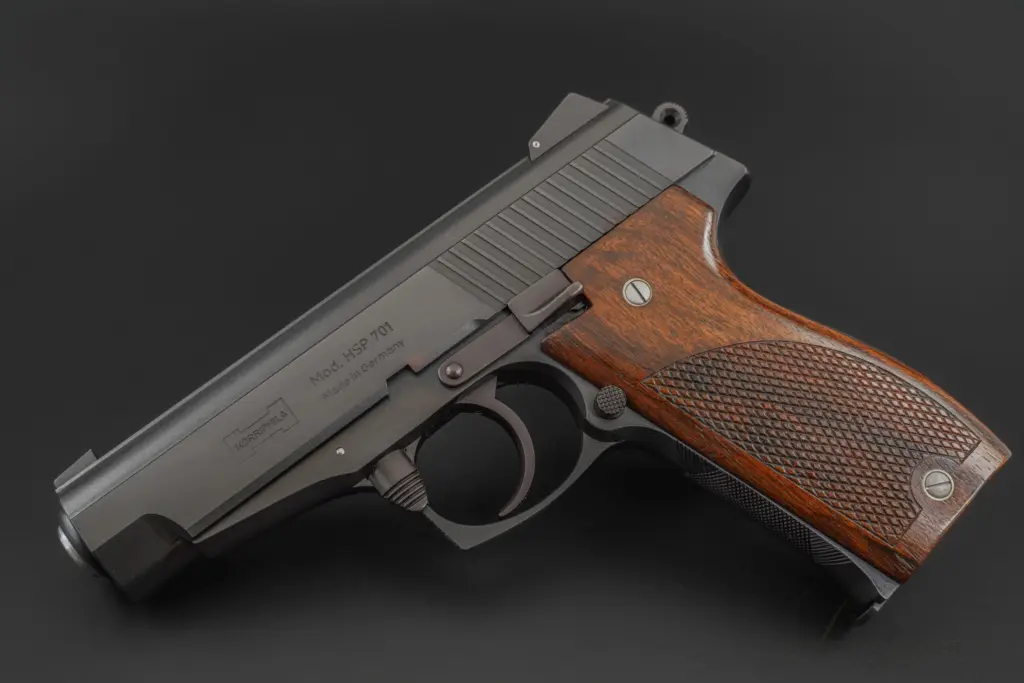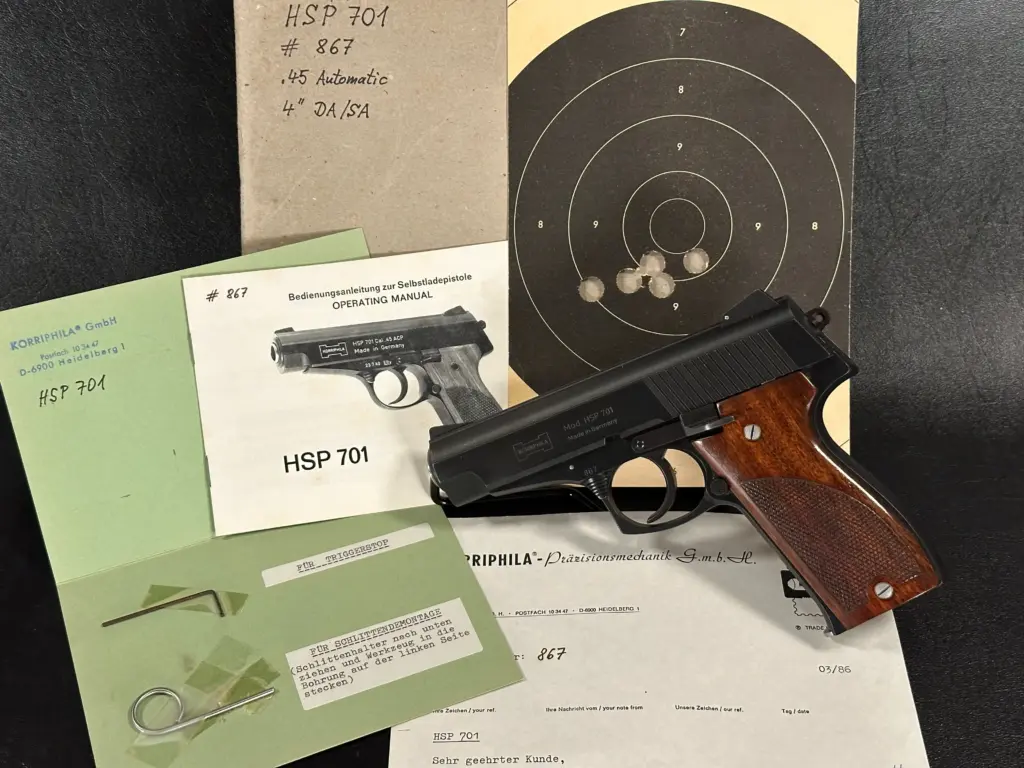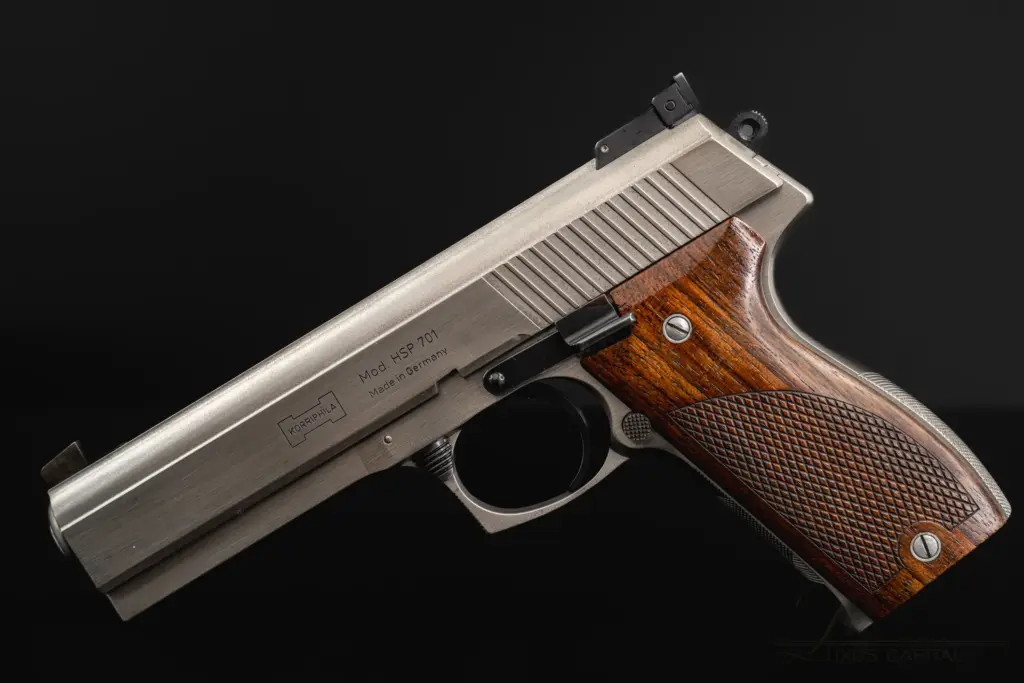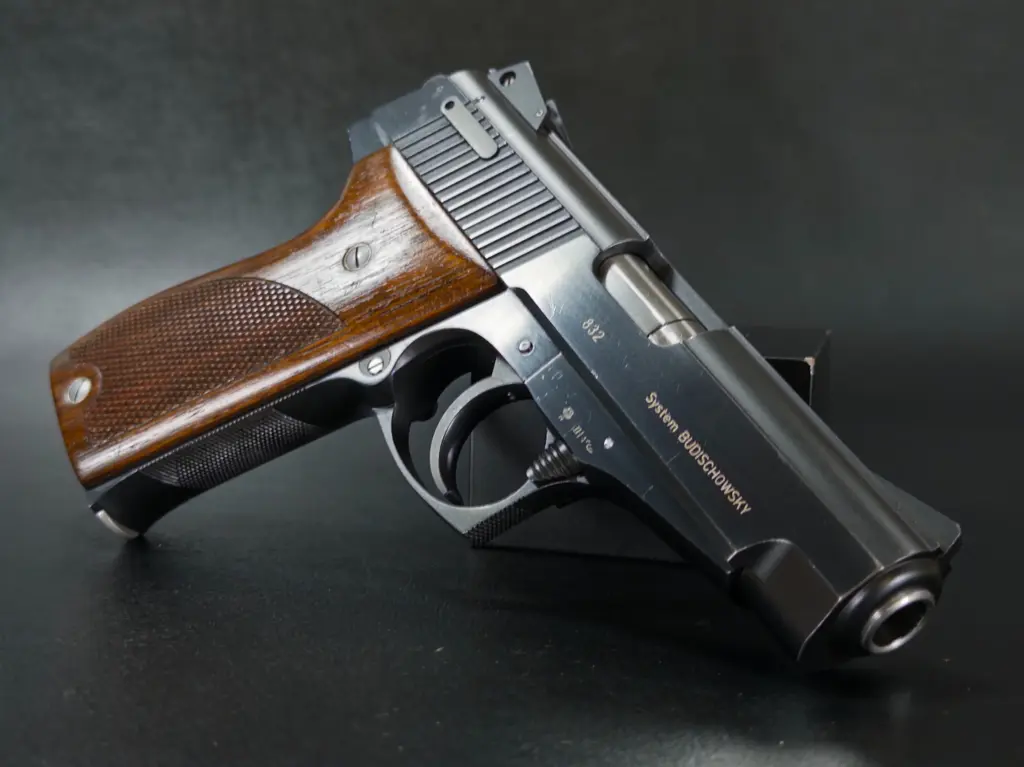The History
Explore The History of Korriphila Firearms
You know how some people are just born with that tinkerer’s brain — the kind that’s always disassembling clocks, fixing bikes, or taking apart radios just to see how they tick? That was Edgar Budischowsky. Born in post-war Germany, surrounded by the wreckage of a world that had just imploded, Edgar wasn’t thinking about politics or philosophy. He was just a kid who loved machines.
Funny enough, he didn’t start out trying to reinvent the wheel — or the handgun, for that matter. His early years weren’t spent in some big factory or design studio. Nope. Picture more of a small workshop, probably cluttered and noisy, with parts scattered around like breadcrumbs. That’s where the real magic started happening.

Tinkering His Way In
Edgar Budischowsky's Vision
Budischowsky’s early fascination with firearms wasn’t exactly unique — lots of kids grew up around them in post-war Europe. What was different was the way he saw them. Not just as tools, but as mechanical puzzles. Precision instruments with infinite room for improvement. It’s the kind of mindset that doesn’t lend itself to shortcuts.
His first big splash? The TP-70. A compact semi-automatic pistol designed in the late 1960s, the TP-70 was a kind of “pocket rocket” — sleek, small, and chambered in .22 LR and .25 ACP. It wasn’t flashy, but it was clever. Solid design, smart safety features, and just enough innovation to catch people’s attention.
And it did. In fact, it caught the attention of folks in America, which led to the TP-70 being licensed and sold under the Norton brand in the U.S. That was Budischowsky’s first brush with international exposure, and — let’s be real — probably his first big disappointment, too.

When Mass Production Meets a Perfectionist
Here’s where it gets interesting. Most designers would’ve taken the licensing deal, collected their check, and moved on. But Budischowsky wasn’t wired like that. He didn’t want to see his designs diluted or his name stamped on something subpar. And honestly? That’s exactly what started happening.
Once the TP-70 crossed the Atlantic, it got… well, “Nortonized.” Manufactured with less precision, using cheaper materials — basically everything Budischowsky hated. It’s no wonder he pulled back. For him, it wasn’t about volume or market share. It was about the work — the craftsmanship, the feel, the click of parts moving just right.
So, what do you do when the world wants you to go big and you want to go small and perfect?
You start your own thing on your own terms.
Korriphila: The Brand That Almost Wasn’t
So, after the TP-70 debacle — okay, maybe not a full-blown disaster, but definitely not what Edgar Budischowsky had in mind — he could’ve just walked away. I mean, a lot of designers would’ve thrown in the towel after seeing their work get watered down and mass-produced. But Budischowsky? Not really the giving-up type.
Instead, he doubled down. Not on scale or sales, but on craftsmanship. Like, the obsessive kind. The kind where you spend hours perfecting a single part that most people will never even see. That’s where Korriphila comes in — not just as a brand, but kind of as a philosophy.
What’s in a Name?
Let’s be honest: “Korriphila” sounds like it could be anything — a pharmaceutical company, maybe a forgotten Greek island, or some obscure mythological creature. But no, it’s the name Budischowsky gave to his ultra-niche firearms brand. Why? Well, the exact origin is a bit of a mystery. He never made a big fuss about explaining it.
Some folks think it’s a play on “corre” (to correct or perfect) and “philia” (a love for something). So maybe it loosely translates to “a love for precision” or “a passion for perfection.” Which, honestly, tracks. Because if there’s one thing you can say about Korriphila guns, it’s that they were made with borderline-irrational levels of attention to detail.
Whatever the case, the name stuck — and it definitely gave off the right kind of vibe: mysterious, refined, and a little bit underground.

Not Your Average Gun Company
Here’s the wild part. Korriphila wasn’t really a “company” in the traditional sense. There were no big factories, no mass production lines, no slick marketing campaigns. Instead, it was more like Budischowsky’s personal workshop with a nameplate. A one-man (okay, maybe a few-man) show where every gun was made slowly, methodically, and exactly how he wanted.
He didn’t care about pumping out thousands of pistols a month. Honestly, he probably didn’t care about pumping out ten. What mattered was quality — and not in the “we use the best materials” brochure-speak kind of way. More like: we spend an absurd amount of time hand-fitting each part until it’s flawless.
That approach meant long lead times, small batches, and — you guessed it — high prices. But it also meant that every Korriphila pistol felt like a work of art. Not decorative art — Budischowsky wasn’t about engraving or embellishment. His art was engineering art.

Slow Guns, Small Batches, Big Impact
Let’s talk numbers for a second — not because they’re the most crucial part, but because they help paint the picture. Total Korriphila HSP-701 pistols made? Fewer than 400 Korriphila HSP-701 pistols were made. That’s it over decades. Some years, production barely hit double digits.
And yet… those few guns? They’ve developed something of a cult following. Collectors were whispering about serial numbers, and forum threads spiraled into lengthy debates about minute differences between early and late models. Why? Because each one feels special — and not in a marketing gimmick way.
It’s like… if Ferrari only made 10 cars a year, but each one was hand-built by Enzo himself. That’s what Budischowsky was doing. On his timeline. In his way.
And honestly? That’s probably why Korriphila never “blew up” the way some brands do. It wasn’t meant to. It was never about “scaling.” It was about building something better than anything else out there, even if only a handful of people ever got to hold one.
You know how some things have presence? Like, you pick them up and immediately know — oh yeah, this is special. That’s the Korriphila HSP-701 in a nutshell. It doesn’t shout. It doesn’t need to. It just sits there, solid and refined, like it knows exactly what it is — and doesn’t care whether you get it or not.
And that? That’s the magic.
A Design That Refuses to Compromise
Let’s get one thing straight up front: the HSP-701 isn’t some flashy, futuristic-looking gun. There’s no wild styling, no crazy colors, no rails, no gimmicks. Just clean, precise lines. You could almost say it’s understated — until you start really looking at it.
Budischowsky’s goal with the HSP-701 was simple (or so it seemed): build the best semi-automatic pistol possible, without cutting corners. At all. Ever.
He designed it as a double-action, single-stack .45 ACP handgun, which already makes it kind of an outlier. Most DA pistols at the time leaned toward 9mm, for reasons of capacity and recoil. But Budischowsky didn’t care about trends. He cared about feel. And he thought the .45, in a well-balanced platform, had a kind of inherent authority — not just in power, but in presence.
And about that double-action trigger: it’s silky. Like, weirdly smooth for something mechanical. Most DA triggers feel like you’re hauling a cable through molasses. The HSP-701? More like drawing a bowstring — deliberate, but graceful. Again, no accident. Every part was hand-fitted, polished, and fine-tuned until it was just right.
The Weird Genius of the Slide Stop Decocker
Now, here’s where things get a little quirky — in a good way. One of the standout features of the HSP-701 is its slide stop decocker. Yeah, you read that right. Budischowsky combined the two functions into a single control. Some folks find it a bit odd at first. But once you get used to it? It’s kind of brilliant.
Think about it: fewer controls, fewer parts, less to go wrong — and more importantly, fewer chances for a sloppy design to sneak in. The decocker works smoothly, with just enough resistance to feel intentional. It’s not there to impress. It’s there because Budischowsky thought it made sense.
And that’s a theme with this gun. Everything on it feels thought through — not just “this is how pistols are usually made,” but “how should this part work, ideally?” Then, he’d machine it that way, no matter how long it took or how hard it was.

Materials Matter
Here’s something collectors love about the HSP-701: it’s overbuilt in the best possible way. The frame? Solid stainless steel. The slide? Same deal. But it’s not just about heft — it’s about how the gun feels in your hand. Balanced. Dense. Like a precision instrument, not just a tool.
And then there’s the stuff inside — the parts most folks never see. Internals are machine-finished, not just slapped together or polished up afterward. Tolerances are tight. Ridiculously tight. Some might even say unnecessarily tight — but that’s Budischowsky for you. He didn’t care about “good enough.” He wanted perfect.
The magazines are even custom-made for the platform — not repurposed from something else. Because, of course, they are.
Shooting It: Not Just a Pretty Face
So how does it shoot? Smooth. Controlled. Almost boringly reliable — in the best way. Recoil is manageable, partly because of the gun’s weight, partly because of how the action works. The trigger reset is short and crisp, and there’s just something satisfying about how each shot feels. Solid. Predictable. No drama.
It’s not a “tactical” gun, at least not in the modern sense. No optics mounts. No threaded barrels (well, except for the rare unicorn customs). No modularity. But honestly? That’s part of the appeal. It’s one man’s vision, fully realized — not a design-by-committee compromise.
Rarity, Serial Numbers, and the Collector’s Chase
Let’s talk collectibility, because this is where the HSP-701 really shines — or haunts, depending on how much sleep you’ve lost chasing one. As mentioned earlier, total production numbers are low, with fewer than 400 made, tops. Some years, only a handful were made. And each one has a serial number that becomes a kind of badge of honor among collectors.
Low serials? Very desirable. Matched pairs? Jackpot. Special variants or calibers? You might have to fight someone for those.
Also, there’s the mystery factor. Records on these guns are a little patchy, which just adds to the legend. You never quite know when or where one will pop up, or what weird detail will make it stand out from the others. One might have custom grips, another might be chambered in 9mm (yes, those exist, though they’re rare). It’s a treasure hunt.
And because Budischowsky kept production so limited — and because Korriphila is now, for all intents and purposes, done — every single HSP-701 is a finite piece of history. No more are coming. Which is why, when one comes up for sale, it doesn’t last long.
The Legacy: Quiet, Powerful, Enduring
So what’s the legacy here? The HSP-701 isn’t as famous as a 1911 or a Glock. It’s not in video games. It doesn’t show up in action movies. And honestly? That’s kind of perfect. It’s a gun for people who care about craftsmanship, not clout.
Budischowsky never set out to make something mainstream. He made something he could be proud of — something that felt like the purest expression of his craft. And that’s why the Korriphila HSP-701 still holds this weird, powerful sway over collectors and enthusiasts.
It’s the kind of gun you don’t just buy — you find it. Maybe after months of searching. Maybe by pure luck. But when you finally hold one? You get it.
